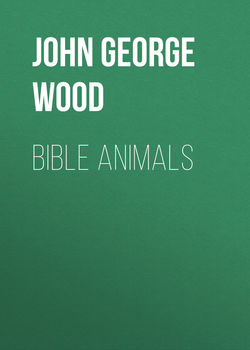Читать книгу Bible Animals - John George Wood - Страница 27
MAMMALIA
THE PYGARG, OR ADDAX
ОглавлениеThe Dishon or Dyshon—Signification of the word Pygarg—Certainty that the Dishon is an antelope, and that it must be one of a few species—Former and present range of the Addax—Description of the Addax—The Strepsiceros of Pliny.
There is a species of animal mentioned once in the Scriptures under the name of Dishon which the Jewish Bible leaves untranslated, and merely gives as Dyshon, and which is rendered in the Septuagint by Pugargos, or Pygarg, as one version gives it. Now, the meaning of the word Pygarg is white-crouped, and for that reason the Pygarg of the Scriptures is usually held to be one of the white-crouped antelopes, of which several species are known. Perhaps it may be one of them—it may possibly be neither, and it may probably refer to all of them.
But that an antelope of some kind is meant by the word Dishon is evident enough, and it is also evident that the Dishon must have been one of the antelopes which could be obtained by the Jews. Now as the species of antelope which could have furnished food for that nation are very few in number, it is clear that, even if we do not hit upon the exact species, we may be sure of selecting an animal that was closely allied to it. Moreover, as the nomenclature is exceedingly loose, it is probable that more than one species might have been included in the word Dishon.
Modern commentators have agreed that there is every probability that the Dishon of the Pentateuch was the antelope known by the name of Addax.
This handsome antelope is a native of Northern Africa. It has a very wide range, and, even at the present day, is found in the vicinity of Palestine, so that it evidently was one of the antelopes which could be killed by Jewish hunters. From its large size, and long twisted horns, it bears a strong resemblance to the Koodoo of Southern Africa. The horns, however, are not so long, nor so boldly twisted, the curve being comparatively slight, and not possessing the bold spiral shape which distinguishes those of the koodoo.
THE ADDAX, OR PYGARG OF SCRIPTURE.
"These are the beasts which ye shall eat: the ox, the sheep, … the pygarg, and the wild ox, and the chamois."—Deut. xiv. 4, 5.
The ordinary height of the Addax is three feet seven or eight inches, and the horns are almost exactly alike in the two sexes. Their length, from the head to the tips, is rather more than two feet. Its colour is mostly white, but a thick mane of dark black hair falls from the throat, a patch of similar hair grows on the forehead, and the back and shoulders are greyish brown. There is no mane on the back of the neck, as is the case with the koodoo.
The Addax is a sand-loving animal, as is shown by the wide and spreading hoofs, which afford it a firm footing on the yielding soil. In all probability, this is one of the animals which would be taken, like the wild bull, in a net, being surrounded and driven into the toils by a number of hunters. It is not, however, one of the gregarious species, and is not found in those vast herds in which some of the antelopes love to assemble.
Some writers reject the Addax as the Dishon, and are inclined to consider that the real representative of the word is to be found in the Ariel or Isabella gazelles. Of these, however, we have already treated, and enough has been said about them to show that these gazelles are in all probability comprised under the name Tsebi.
It has been suggested, in contradiction to the opinion that the Dishon is the Addax, that the word Strepsiceros, or Twisted Horn, is given to it by Pliny, who also mentions that one of the native names for the animal is Adas, or Akas, and that he distinguishes it from the Pygarg. Still, the weight of evidence is so great in favour of the identity of the Dishon and the Pygarg, that we may accept the interpretation with safety.
